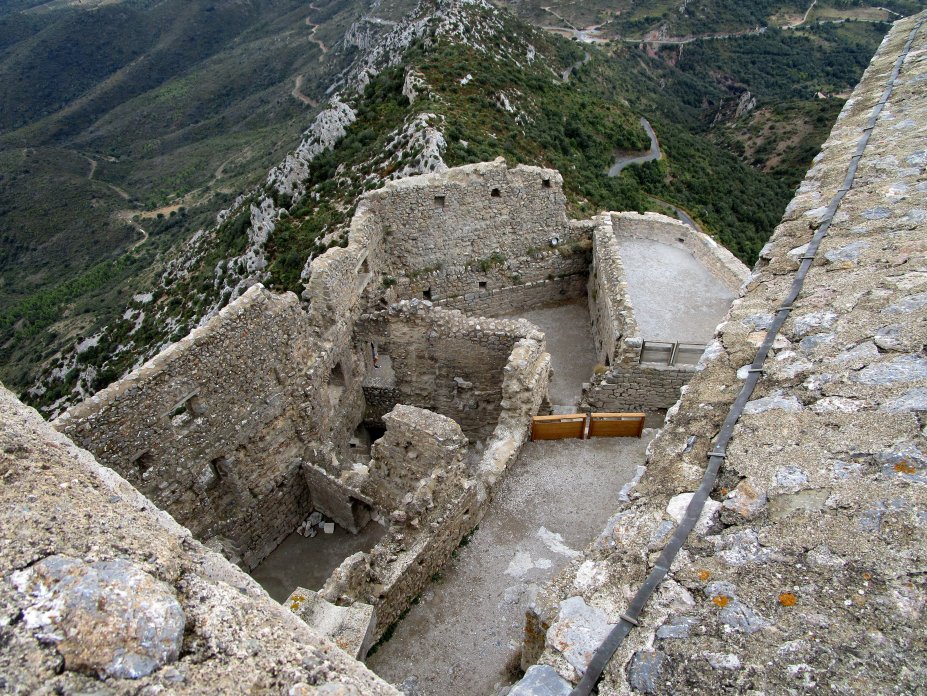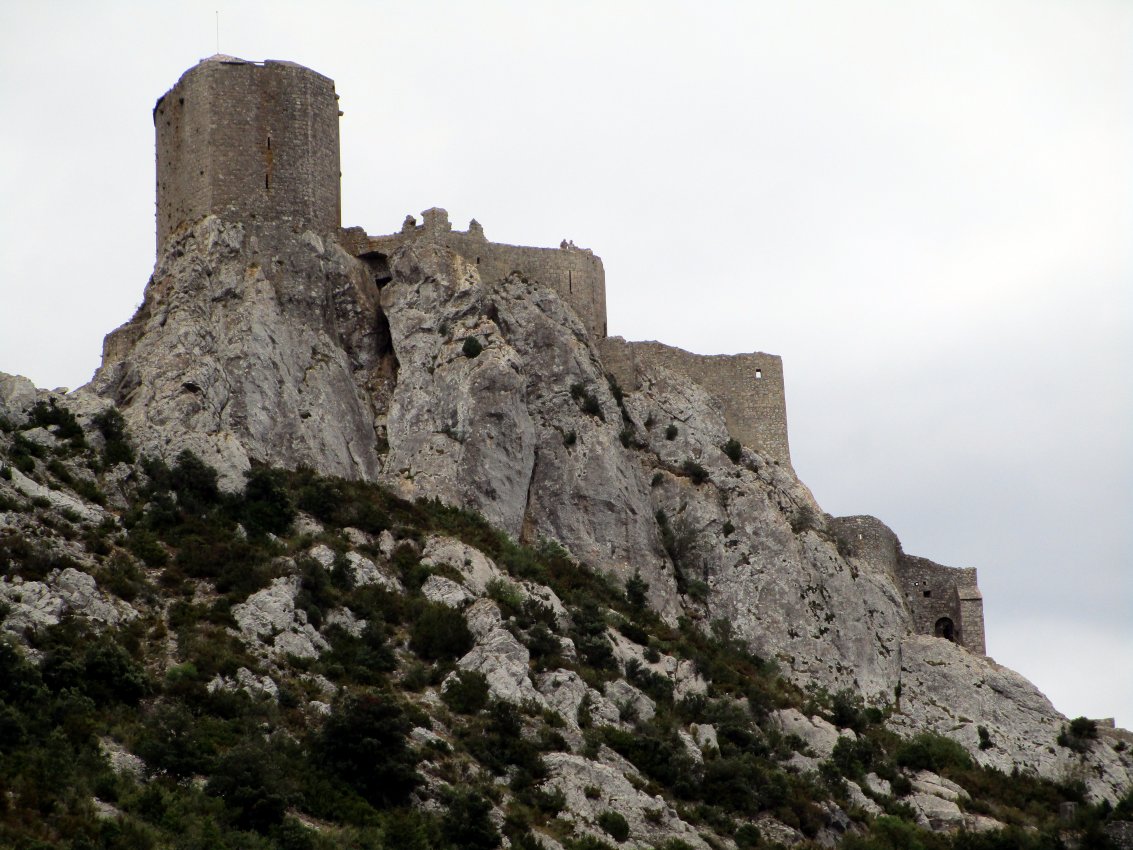Queribus
In 1483, Queribus was another castle described as one of the ‘5 sons of Carcassonne' with Aguilar, Peyrepertuse, Puilaurens and Termes.
The name has since stuck and is often applied retrospectively to the
castles which guarded the French border with Aragon since the 1258
treaty of Corbeil.
Queribus castle was first mentioned in the will of Count Bernard
Cerdanya of Besalu in 1020 when he divided his lands amongst his heirs.
William (d.1052), his eldest son, received his title with the
castles of Besalu, Ausone, Fenouillet, Peyrepertuse, Popia and Queribus (Cherbucio)... as well as the castles of Penne and Tautavel (Taltevolo).
In 1066 Viscount Berenger of Narbonne (d.1067+) paid homage to
William's son and heir, another Count William of Besalu (d.1070) for
Queribus castle which had been given to his wife, Garsinde Besalu
(d.1067+) by her father, Count Bernard (d.1020). Interestingly
this gift does not appear in the count's 1020 will. Regardless,
the castle remained a property held by the counts of Narbonne of the
counts of Besalu until 1111 when Barcelona swallowed up Besalu.
The next year Count Raymond Berenger of Barcelona (d.1131),
recorded the castle amongst his assets when he married Dulce Millau
(d.bef.1130). The castle was held under him by Viscount Aimery of
Narbonne (d.1134).
Like its neighbours, Aguilar, Peyrepertuse, Puilaurens and
Tautavel, Queribus remained part of the lordship of Barcelona.
They then became royal fortressess when Raymond Berenger's
grandson, Alphonso (d.1195) became king of Aragon in 1162. Sometime in this era the viscounts of Narbonne lost their tenancy of Queribus and it passed
into the control of the counts of Roussillon and Fenouillet until their
line died out in 1172/3. By 1193 it was under the control of
Berenger, the leading member of the Cucugnan
family, ardent supporters of the Cathars. Several members of
this family became perfaits. From Berenger the castle seems to
have passed to Arnaud Cucugnan who died after 1248. During this time his
apparent son, Peter Cucugnan, was prominent in supporting the
Cathars. Before 1240 he helped supply Puilaurens castle
and received the exiled Cathar knight Gerard Aniort in his fortress as
well as the Cathar Bishop Benoit Termes who died at Queribus in the
period 1233-41. In 1240 he marched with the other rebels on Carcassonne,
but then surrendered to Louis IX (d.1270) following the failure of this
expedition. Peter seems to have died around 1247, leaving a son
Arnaud who took the name Soulatge after his mother. Possibly this
means that he was dispossessed of Queribus and nearby Cucugnan.
However, the castle remained a Cathar stronghold, offering refuge to
Deacon Benoit Termes of Razes until his death.
During the Albigensian Crusade (1209-29) Queribus played only a small
part. As a land of the king of Aragon it was not attacked during
the early stages of the war. After the defeat and death of its
lord, King Peter of Aragon, at the battle of Muret on 12 September
1213, the fortress, together with the Fenolhedes and Perapertuses,
became a refuge for the defeated lords or faydits as they were
known. The castle, however, seems to have played no other part in
the warfare. After the battle of Muret, Viscount Aimery of
Narbonne (d.1234) and Count Sancho of Cerdanya (d.1223) with his son,
Nuno Sanchez (d.1242), prepared an army at Narbonne to avenge King
Peter and rescue his son, King James I (d.1276) from Simon Montfort
(d.1218). The campaign never got underway as James was returned
to the Aragonese. Sancho and his son, Nuno, remained hostile to
the Crusaders and provided sanctuary to Count Raymond VI of Toulouse
(d.1223) when he was exiled in 1216. In 1218 Sancho was removed
from his regency of King James of Aragon, but maintained his opposition
to the Crusaders as count of Roussillon and Cerdanye. Quite
possibly he used Queribus for this purpose, although in 1212 he had
handed control of both his counties over to his son Nuno Sanchez
(d.1242).
In 1226 Nuno purchased the viscounties of Fenouilledes and Peyrepertuse
from Louis VIII (d.1228) and did homage to the French king for them,
thereby accepting them as part of France and not Aragon. Possibly
this was to ensure they were not attacked by the new crusade the king
was planning. In 1238 Nuno crusaded with King James against
Valencia and the next year sold Queribus and Peyrepertuse
castles to King Louis IX (d.1270) for 20,000 Melgorian sou. The
sale, however, does not seem to have been effective for it was another
16 years before Louis was able to exert his lordship in the castles.
In 1255 Queribus castle was held by Chabert Barbaira. He was a
militry engineer of King James of Aragon who had been invested with all
the military strong points in the Fenouillet by the king in 1242.
On 5 May 1255 Seneschal Peter Auteuil of Carcassonne asked the
archbishop of Narbonne to aid him in taking Queribus castle 'a refuge
for heretics...'. Chabert then fell into the hands of the reformed Cathar supporter Oliver Termes
(d.1274).
He and Chabert had earlier jointly taken part in the capture of
Majorca for King James of Aragon in 1229. Now Chabert was
imprisoned by his old companion at Aguilar castle before exchanging Queribus and probably Puilaurens
for his life. He was still living and free in Andorra on 12
September 1278 when he witnessed an agreement between the count of Foix
and the church of Urgel.
These castles were therefore the last Cathar fortresses to oppose Louis IX after the fall of Montsegur
in 1244. In June 1255 the first recorded royal garrison consited
of 20 seargents at 8d per day. After the treaty of Corbeil on 11
May 1258 this garrison was soon reduced and in the 1260s the garrison
of Queribus, like that of
nearby Peyrepertuse, consisted of only 9 sergeants. In comparison Puilaurens
had 25.
Between 1404, when the chapel was renovated and 1689, the priests of
Cucugnan performed mass in the castle chapel dedicated to St Louis
(d.1270). The castle then remained a French stronghold on the
Spanish border, falling briefly to Spain in 1473-75, until the border
moved further south by the Treaty of the Pyrenees in 1659. The
converstion of the keep to mount artillery probably dates to the
sixteenth century.
Description
The castle stands on the highest crag in the foothills of the Pyrenees,
2,390' high. It runs roughly east to west in orientation, gaining
in height as the defences are passed through on the way to the keep at
the western peak of the fortress. The castle is entered at the NW
extremity by a doorway hidden behind a solid western buttress and
covered from the wall above to N&W. The approach steps,
defended by a barbican are also covered from 3 murder chutes arranged
in the facing wall as well as decorative cannonballs. Around the
corner buttress the main gate consisted of a Romanesque arch with one
side corbelled out from the buttress protected by a Byzantine murder
chute above. Many of these are found in Sicily, viz: Calatabianco
and Sperlinga. Within the outer gate at Queribus was another,
smaller Romanesque arch protected by a portcullis. On the
interior side was a slightly pointed arch and more steps dog-legging up
and around the rock towards the next ward. Inside the gate a
wallwalk ran from the SW around and over the gate allowing access to
the portcullis raising mechanism. Above to the north were steps
up giving access to the rounded wall top which covered the exterior of
the entrance. This 5' thick Arnaud CommingesllFenouillet was equipped with a crossbow loop and another
murder chute.
 From
the gate, steps lead up to the outer ward from this barbican.
This consisted of a courtyard with a rectangular tower cum barracks
forming its west end. All of this is commanded from the main ward
which is entered centrally from the south via a Romanesque hole in the
wall gate. Above this is a Roman style window comparable to those
found in the city wall at Carcassonne.
Above it again are the remains of a machicolation. The ward
entered then has buildings built against the curtain to W&S.
In the NW corner was a chamber, under which was a water cistern fed by
the roofs of the castle.
From
the gate, steps lead up to the outer ward from this barbican.
This consisted of a courtyard with a rectangular tower cum barracks
forming its west end. All of this is commanded from the main ward
which is entered centrally from the south via a Romanesque hole in the
wall gate. Above this is a Roman style window comparable to those
found in the city wall at Carcassonne.
Above it again are the remains of a machicolation. The ward
entered then has buildings built against the curtain to W&S.
In the NW corner was a chamber, under which was a water cistern fed by
the roofs of the castle.
In the NE corner of the site is the keep, rectangular internally and
polygonal externally. It seems quite feasible that this started
life as an early great square keep. Traces of this can still be
seen around the base to the It was later modified down through the ages
into the current structure. The summit has certainly been cut
down for artillery, perhaps losing as much as a half of its original
height. To the north are 3 blocked crossbow loops that cannot be
in their original positions if the rectangular interior of the keep
marks its original dimensions.
To the SE of the keep is a triangular projection that contains an
internal chamber and a passage that runs off SW to a spiral vice in a
thickened rectangular section of the east curtain wall. The
shoulder-headed doorways in this suggests this latter structure is late
thirteenth or fourteenth century, while the peculiar Romanesque
entrance into the keep suggests that this is much older, although in
reality it is probably much younger. Entered from the stair well
is a chamber which allows access to a thirteenth century casement with
3 loops set beneath the west face of the keep and covering a possible
approach to the castle along the ridge from the east. The nearest equivalent to this would be covered way to the cave at Castell Carreg Cennen in Wales.
Why not join me at other French
castles? Information on this and other tours can be found at Scholarly
Sojourns.
Copyright©2019
Paul Martin Remfry


 From
the gate, steps lead up to the outer ward from this barbican.
This consisted of a courtyard with a rectangular tower cum barracks
forming its west end. All of this is commanded from the main ward
which is entered centrally from the south via a Romanesque hole in the
wall gate. Above this is a Roman style window comparable to those
found in the city wall at Carcassonne.
Above it again are the remains of a machicolation. The ward
entered then has buildings built against the curtain to W&S.
In the NW corner was a chamber, under which was a water cistern fed by
the roofs of the castle.
From
the gate, steps lead up to the outer ward from this barbican.
This consisted of a courtyard with a rectangular tower cum barracks
forming its west end. All of this is commanded from the main ward
which is entered centrally from the south via a Romanesque hole in the
wall gate. Above this is a Roman style window comparable to those
found in the city wall at Carcassonne.
Above it again are the remains of a machicolation. The ward
entered then has buildings built against the curtain to W&S.
In the NW corner was a chamber, under which was a water cistern fed by
the roofs of the castle.